Durban
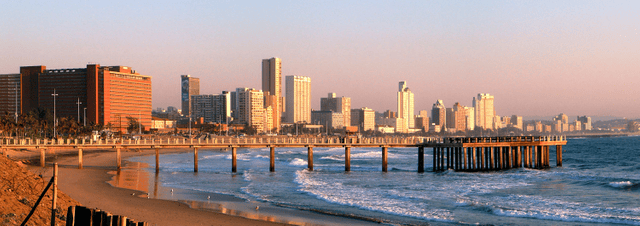
Durban

| Coordinates: | |
| Country | South Africa |
|---|---|
| Province | KwaZulu-Natal |
| Municipality | eThekwini |
| Established | 1880[1][2] |
| Named for | Benjamin D'Urban |
| Government | |
| • Type | Metropolitan municipality |
| • Mayor | Mxolisi Kaunda(ANC) |
| Area | |
| • City | 225.91 km (87.22 sq mi) |
| • Metro | 2,292 km (885 sq mi) |
| Population | |
| • City | 595,061 |
| • Density | 2,600/km (6,800/sq mi) |
| •Metro | 3,442,361 |
| • Metro density | 1,500/km (3,900/sq mi) |
| Demonym(s) | Durbanite[5] |
| Racial makeup (2011) | |
| •Black African | 51.1% |
| •Coloured | 8.6% |
| •Indian/Asian | 24.0% |
| •White | 15.3% |
| • Other | 0.9% |
| First languages(2011) | |
| •English | 49.8% |
| •Zulu | 33.1% |
| •Xhosa | 5.9% |
| •Afrikaans | 3.6% |
| • Other | 7.6% |
| Time zone | UTC+2(SAST) |
| Postal code(street) | |
| PO box | |
| Area code | 031 |
| GDP | US$63.9 billion[6] |
| GDP per capita | US$15,575[6] |
| Website | |
Durban (Zulu: eThekwini, from itheku meaning "bay/lagoon") is the third most populous city in South Africa—after Johannesburg and Cape Town—and the largest city in the South African province of KwaZulu-Natal. Located on the east coast of South Africa, Durban is famous for being the busiest port in the country. It is also seen as one of the major centres of tourism because of the city's warm subtropical climate and extensive beaches. Durban forms part of the eThekwini Metropolitan Municipality, which includes neighboring towns and has a cPopulation of about 3.44 million,[7] making the combined municipality one of the biggest cities on the Indian Ocean coast of the African continent. It is also the second most important manufacturing hub in South Africa after Johannesburg. In 2015, Durban was recognised as one of the New7Wonders Cities (along with Vigan, Doha, La Paz, Havana, Beirut, and Kuala Lumpur).[8] The city was heavily hit by flooding over 4 days from 18 April 2019, leading to 70 deaths and R 650 000 000 in damage.[9][10] Durban was recently named the new darling of South Africa due to its all year round warm weather, long stretches of beaches, traditional cuisine, lively markets, world class hotels and arts districts.[11]
| Coordinates: | |
| Country | South Africa |
|---|---|
| Province | KwaZulu-Natal |
| Municipality | eThekwini |
| Established | 1880[1][2] |
| Named for | Benjamin D'Urban |
| Government | |
| • Type | Metropolitan municipality |
| • Mayor | Mxolisi Kaunda(ANC) |
| Area | |
| • City | 225.91 km (87.22 sq mi) |
| • Metro | 2,292 km (885 sq mi) |
| Population | |
| • City | 595,061 |
| • Density | 2,600/km (6,800/sq mi) |
| •Metro | 3,442,361 |
| • Metro density | 1,500/km (3,900/sq mi) |
| Demonym(s) | Durbanite[5] |
| Racial makeup (2011) | |
| •Black African | 51.1% |
| •Coloured | 8.6% |
| •Indian/Asian | 24.0% |
| •White | 15.3% |
| • Other | 0.9% |
| First languages(2011) | |
| •English | 49.8% |
| •Zulu | 33.1% |
| •Xhosa | 5.9% |
| •Afrikaans | 3.6% |
| • Other | 7.6% |
| Time zone | UTC+2(SAST) |
| Postal code(street) | |
| PO box | |
| Area code | 031 |
| GDP | US$63.9 billion[6] |
| GDP per capita | US$15,575[6] |
| Website | |
History
Archaeological evidence from the Drakensberg mountains suggests that the Durban area has been inhabited by communities of hunter-gatherers since 100,000 BC. These people lived throughout the area of present-day KwaZulu-Natal until the expansion of Bantu farmers and pastoralists from the north saw their gradual displacement, incorporation or extermination. Little is known of the history of the first residents, as there is no written history of the area until it was sighted by Portuguese explorer Vasco da Gama, who sailed parallel to the KwaZulu-Natal coast at Christmastide in 1497 while searching for a route from Europe to India. He named the area "Natal", or Christmas in Portuguese.[12]
First European settlers
In 1822 Lieutenant James King, captain of the ship Salisbury, together with Lt. Francis George Farewell, both ex-Royal Navy officers from the Napoleonic Wars, were engaged in trade between the Cape and Delagoa Bay. On a return trip to the Cape in 1823, they were caught in a very bad storm and decided to risk the Bar and anchor in the Bay of Natal. The crossing went off well and they found safe anchor from the storm. Lt. King decided to map the Bay and named the "Salisbury and Farewell Islands". In 1824 Lt. Farewell, together with a trading company called J. R. Thompson & Co., decided to open trade relations with Shaka the Zulu King and establish a trading station at the Bay. Henry Francis Fynn, another trader at Delagoa Bay, was also involved in this venture. Fynn left Delagoa Bay and sailed for the Bay of Natal on the brig Julia, while Farewell followed six weeks later on the Antelope. Between them they had 26 possible settlers, but only 18 stayed. On a visit to King Shaka, Henry Francis Fynn was able to befriend the King by helping him recover from a stab wound suffered as a result of an assassination attempt by one of his half-brothers. As a token of Shaka's gratitude, he granted Fynn a “25-mile strip of coast a hundred miles in depth.” On 7 August 1824 they concluded negotiations with King Shaka for a cession of land, including the Bay of Natal and land extending ten miles south of the Bay, twenty-five miles north of the Bay and one hundred miles inland. Farewell took possession of this grant and raised the Union Jack with a Royal Salute, which consisted of 4 cannon shots and twenty musket shots. Of the original 18 would-be settlers, only 6 remained, and they can be regarded as the founding members of Port Natal as a British colony. These 6 were joined by Lt. James Saunders King and Nathaniel Isaacs in 1825.
The modern city of Durban thus dates from 1824 when the settlement was established on the northern shores of the bay near today's Farewell Square.[13]
During a meeting of 35 European residents in Fynn's territory on 23 June 1835, it was decided to build a capital town and name it "D'Urban" after Sir Benjamin D'Urban, then governor of the Cape Colony.[14]
Republic of Natalia
The Voortrekkers established the Republic of Natalia in 1839, with its capital at Pietermaritzburg.
Tension between the Voortrekkers and the Zulus prompted the governor of the Cape Colony to dispatch a force under Captain Charlton Smith to establish British rule in Natal, for fear of losing British control in Port Natal.
The force arrived on 4 May 1842 and built a fortification that was later to be The Old Fort. On the night of 23/24 May 1842 the British attacked the Voortrekker camp at Congella. The attack failed, and the British had to withdraw to their camp which was put under siege. A local trader Dick King and his servant Ndongeni were able to escape the blockade and rode to Grahamstown, a distance of 600 km (370 mi) in fourteen days to raise reinforcements. The reinforcements arrived in Durban 20 days later; the Voortrekkers retreated, and the siege was lifted.[15]
Fierce conflict with the Zulu population led to the evacuation of Durban, and eventually the Afrikaners accepted British annexation in 1844 under military pressure.
Durban's historic regalia
When the Borough of Durban was proclaimed in 1854, the council had to procure a seal for official documents.
The seal was produced in 1855 and was replaced in 1882.
The new seal contained a coat of arms without helmet or mantling that combined the coats of arms of Sir Benjamin D’Urban and Sir Benjamin Pine.
An application was made to register the coat of arms with the College of Arms in 1906, but this application was rejected on grounds that the design implied that D’Urban and Pine were husband and wife. Nevertheless, the coat of arms appeared on the council's stationery from about 1912. The following year, a helmet and mantling was added to the council's stationery and to the new city seal that was made in 1936. The motto reads "Debile principium melior fortuna sequitur"—"Better fortune follows a humble beginning".
Government and politics
With the end of apartheid, Durban was subject to restructuring of local government. The eThekwini Metropolitan Municipality was formed in 1994 after South Africa's first multiracial elections, with its first mayor being Sipho Ngwenya. The mayor is elected for a five-year term; however Sipho Ngwenya only served two years. In 1996, the city became part of the Durban UniCity in July 1996 as part of transitional arrangements and to eThekwini Metropolitan Municipality in 1999, with the adoption of South Africa's new municipal governance system. In July 1996, Obed Mlaba was appointed mayor of Durban UniCity; in 1999 he was elected to mayor of the eThekwini municipality and re-elected in 2006. Following the May 2011 local elections, James Nxumalo, the former Speaker of the Council, was elected as the new mayor. On 23 August 2016 Zandile Gumede was elected as the new mayor until the 13 August 2019.[18] On 5 September 2019 Mxolisi Kaunda was sworn in as the new mayor.[19]
The name of the Durban municipal government, prior to the post-apartheid reorganisations of municipalities, was the Durban Corporation or City of Durban.[20]
Geography
Durban is located on the East coast of South Africa, looking out upon the Indian Ocean. The city lies at the mouth of the Umgeni River, which demarcates parts of Durban's north city limit, while other sections of the river flow through the city itself. Durban has a natural harbour, Durban Harbour, which is the busiest port in South Africa and is the 4th-busiest in the Southern hemisphere.
Climate
Durban has a humid subtropical climate (Köppen climate classification Cfa), with hot and humid summers and pleasantly warm and dry winters, which are snow and frost-free. Durban has an annual rainfall of 1,009 millimetres (39.7 in). The average temperature in summer ranges around 24 °C (75 °F), while in winter the average temperature is 17 °C (63 °F).
| Climate data for Durban (1961–1990) | |||||||||||||
|---|---|---|---|---|---|---|---|---|---|---|---|---|---|
| Month | Jan | Feb | Mar | Apr | May | Jun | Jul | Aug | Sep | Oct | Nov | Dec | Year |
| Record high °C (°F) | 36.2(97.2) | 33.9(93.0) | 34.8(94.6) | 36.0(96.8) | 33.8(92.8) | 35.7(96.3) | 33.8(92.8) | 35.9(96.6) | 36.9(98.4) | 40.0(104.0) | 33.5(92.3) | 35.9(96.6) | 40.0(104.0) |
| Mean maximum °C (°F) | 32.6(90.7) | 31.7(89.1) | 32.0(89.6) | 30.4(86.7) | 30.2(86.4) | 28.8(83.8) | 28.9(84.0) | 29.7(85.5) | 30.3(86.5) | 30.5(86.9) | 30.6(87.1) | 32.0(89.6) | 34.5(94.1) |
| Average high °C (°F) | 27.8(82.0) | 28.0(82.4) | 27.7(81.9) | 26.1(79.0) | 24.5(76.1) | 23.0(73.4) | 22.6(72.7) | 22.8(73.0) | 23.3(73.9) | 24.0(75.2) | 25.2(77.4) | 26.9(80.4) | 25.2(77.4) |
| Daily mean °C (°F) | 24.1(75.4) | 24.3(75.7) | 23.7(74.7) | 21.6(70.9) | 19.1(66.4) | 16.6(61.9) | 16.5(61.7) | 17.7(63.9) | 19.2(66.6) | 20.1(68.2) | 21.4(70.5) | 23.1(73.6) | 20.6(69.1) |
| Average low °C (°F) | 21.1(70.0) | 21.1(70.0) | 20.3(68.5) | 17.4(63.3) | 13.8(56.8) | 10.6(51.1) | 10.5(50.9) | 12.5(54.5) | 15.3(59.5) | 16.8(62.2) | 18.3(64.9) | 20.0(68.0) | 16.5(61.7) |
| Mean minimum °C (°F) | 17.3(63.1) | 17.1(62.8) | 16.1(61.0) | 12.1(53.8) | 8.7(47.7) | 5.9(42.6) | 5.8(42.4) | 7.3(45.1) | 10.0(50.0) | 11.9(53.4) | 13.8(56.8) | 15.9(60.6) | 5.3(41.5) |
| Record low °C (°F) | 14.0(57.2) | 13.3(55.9) | 11.6(52.9) | 8.6(47.5) | 4.9(40.8) | 3.5(38.3) | 2.6(36.7) | 2.6(36.7) | 4.5(40.1) | 8.3(46.9) | 10.3(50.5) | 11.8(53.2) | 2.6(36.7) |
| Average rainfall mm (inches) | 134(5.3) | 113(4.4) | 120(4.7) | 73(2.9) | 59(2.3) | 38(1.5) | 39(1.5) | 62(2.4) | 73(2.9) | 98(3.9) | 108(4.3) | 102(4.0) | 1,019(40.1) |
| Average rainy days(≥ 0.1 mm) | 15.2 | 12.9 | 12.6 | 9.2 | 6.8 | 4.5 | 4.9 | 7.1 | 11.0 | 15.1 | 16.0 | 15.0 | 130.3 |
| Averagerelative humidity(%) | 80 | 80 | 80 | 78 | 76 | 72 | 72 | 75 | 77 | 78 | 79 | 79 | 77 |
| Mean monthlysunshine hours | 184.0 | 178.8 | 201.6 | 206.4 | 223.6 | 224.9 | 230.4 | 217.0 | 173.3 | 169.4 | 166.1 | 189.9 | 2,365.4 |
| Source #1: World Meteorological Organization[21] | |||||||||||||
| Source #2: NOAA (sun, extremes and humidity) | |||||||||||||
Demographics

Geographical distribution of home languages in eThekwini metropole Afrikaans English Xhosa Zulu No language dominant
Durban is ethnically diverse, with a cultural richness of mixed beliefs and traditions.
Zulus form the largest single ethnic group. It has a large number of people of British and Indian descent. The influence of Indians in Durban has been significant, bringing with them a variety of cuisine, culture and religion.[23]
In the years following the end of Apartheid there was a population boom as Africans were allowed to move into the city.
The population grew by 2.34% between 1996 and 2001.
This led to shanty towns forming around the city which were often demolished.
Between 2001 and 2011 the population growth slowed down to 1.08% per year and shanty towns have become less common as the government builds low-income housing.[4]
The population of the city of Durban and central suburbs such as Durban North, Durban South and the Berea increased 10.9% between 2001 and 2011 from 536,644 to 595,061.[25][3] The number of Black Africans increased while the number of people in all the other racial groups decreased. Black Africans increased from 34.9% to 51.1%. Indian or Asians decreased from 27.3% to 24.0%. Whites decreased from 25.5% to 15.3%. Coloureds decreased from 10.26% to 8.59%. A new racial group, Other, was included in the 2011 census at 0.93%.
The city's demographics indicate that 68% of the population are of working age, and 38% of the people in Durban are under the age of 19 years.[27]
It has the highest number of dollar millionaires added per year of any South African city with the number rising 200 per cent between 2000 and 2014.[28]
Informal sector
Durban has a number of informal and semi-formal street vendors.
The Warwick Junction Precinct is home to a number of street markets, with vendors selling goods from traditional medicine, to clothing and spices.[29]
The city's treatment of shack dwellers has been strongly criticised by a report from the United Nations linked Centre on Housing Rights and Evictions[30] and there has also been strong criticism of the city's treatment of street traders,[31][32] street children[33] and sex workers.[34] Durban is known throughout the world for its strain of cannabis called 'Durban Poison'. It is one of the most common strains sold by car guards and street dealers throughout eThekweni.[35]
Civil society
There are a number of prominent civil society organisations based in Durban.
These include: Abahlali baseMjondolo (shack-dwellers') movement,[36] the Diakonia Council of Churches, the Right2Know Campaign, the South Durban Community Environmental Alliance and the South African Unemployed Peoples' Movement.[37][38][39][40][41][42] The Durban Art Gallery was founded in 1892.
Nature and wildlife
Stadiums and sports facilities
Moses Mabhida Stadium. Activities include a Skycar ride or Adventure Walk to the top of the arch with 360 degree views over Durban; Guinness world record Bungee swing; Segway gliding tours of the stadium; Cafes and Restaurants; Monthly I Heart Durban market;
Kingsmead Cricket Ground is a major test match and one-day cricket venue.
Kings Park Stadium is host to the internationally renowned Sharks Rugby Team.
Greyville Racecourse (home of the Durban July Handicap) and Durban Country Club and golf course.
Durban Ice Arena Activities include leisure ice skating, birthday parties, school excursions, sporting events, teambuilding activities, corporate functions and group bookings.
Communications and media
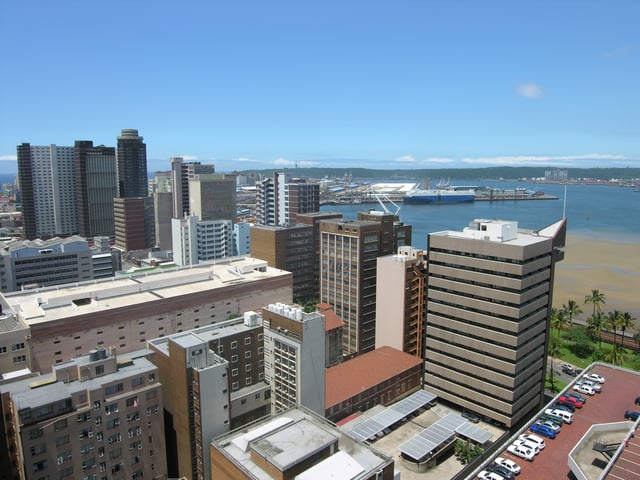
View of Durban harbor
Two major English-language daily newspapers are published in Durban, both part of the Independent Newspapers, the national group owned by Sekunjalo Investments. These are the morning editions of The Mercury and the afternoon Daily News. Like most news media in South Africa, they have seen declining circulations in recent years. Major Zulu language papers comprise Isolezwe ( Independent Newspapers), UmAfrika and Ilanga. Independent Newspapers also publish Post, a newspaper aimed largely at the Indian community. A national Sunday paper, the Sunday Tribune is also published by Independent Newspapers as is the Independent on Saturday.
A major city initiative is the eZasegagasini Metro Gazette.[47]
The national broadcaster, the SABC, has regional offices in Durban and operates two major stations there.
The Zulu language Ukhozi FM has a huge national listenership of over 6.67 million, which makes it the second largest radio station in the world. The SABC also operates Radio Lotus, which is aimed at South Africans of Indian origin. The other SABC national stations have smaller regional offices in Durban, as does TV for news links and sports broadcasts. A major English language radio station, East Coast Radio,[48] operates out of Durban and is owned by SA media giant Kagiso Media. There are a number of smaller stations which are independent, having been granted licences by ICASA, the national agency charged with the issue of broadcast licences.
Sports teams and events

Kingsmead Cricket Ground, Durban in 2009

Moses Mabhida stadium in Durban
Durban is home to the Cell C Sharks, who compete in the domestic Currie Cup competition as well as in the international Super Rugby competition. The Sharks' home ground is the 56,000 capacity Kings Park Stadium, sometimes referred to as the Shark Tank.
The city is home to two clubs in the Premier Soccer League — AmaZulu, and Golden Arrows. AmaZulu play most of their home games at the Moses Mabhida Stadium. Golden Arrows play most of their home games at the King Zwelithini Stadium in the suburb of Umlazi, but sometimes play some of their matches at Moses Mabhida Stadium or Chatsworth Stadium. It is also a home to some teams tha are playing in the NFD such as Royal Eagles FC and Royal Kings
Durban is host to the KwaZulu-Natal cricket team, who play as the Dolphins when competing in the Sunfoil Series. Shaun Pollock, Jonty Rhodes, Lance Klusener, Barry Richards, Andrew Hudson, Hashim Amla, Vince van der Bijl, Kevin Pietersen, Dale Benkenstein and David Miller are all players or past players of the Natal cricket team. International cricketers representing them include Malcolm Marshall, Dwayne Bravo and Graham Onions. Cricket in Durban is played at Kingsmead cricket ground.
Durban hosted matches in the 2003 ICC Cricket World Cup. In 2007 the city hosted nine matches, including a semi-final, as part of the inaugural ICC World Twenty20. The 2009 IPL season was played in South Africa, and Durban was selected as a venue. 2010 saw the city host six matches, including a semi-final, in the 2010 Champions League Twenty20.
Durban was one of the host cities of the 2010 FIFA World Cup, and A1GP held a race on a street circuit in Durban from 2006–2008. Durban hosted the 123rd IOC Session in July 2011.
The city is home to Greyville Racecourse, a major Thoroughbred horse racing venue which annually hosts a number of prestigious races including the country's premier event, the July Handicap, and the premier staying event in South Africa, the Gold Cup. Clairwood racecourse, south of the city, was a popular racing venue for many years, but was sold by the KZN racing authority in 2012.[51][52]
Durban hosts many famous endurance sports events annually, such as the Comrades Marathon, Dusi Canoe Marathon and the Ironman 70.3.
Transport
Air
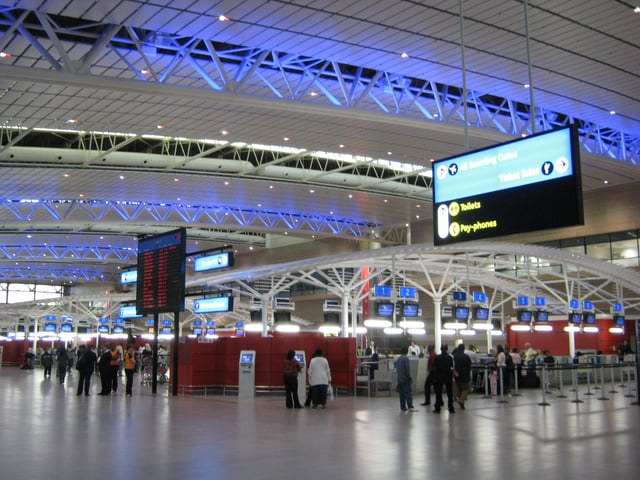
King Shaka International Airport
King Shaka International Airport services both domestic and international flights, with regularly scheduled services to London Heathrow, Dubai, Istanbul, Doha, Mauritius, Lusaka, Windhoek and Gaborone, as well as eight domestic destinations. The airport's position forms part of the Golden Triangle between Johannesburg and Cape Town, which is important for convenient travel and trade between these three major South African cities. The airport opened in May 2010. King Shaka International Airport handled 5.99 million passengers in 2018/2019, up 6.6 percent from 2017/2018. King Shaka International was constructed at La Mercy, about 36 kilometres (22 mi) north of central Durban. All operations at Durban International Airport have been transferred to King Shaka International as of 1 May 2010, with plans for flights to Singapore, Mumbai, Kigali, Luanda, Lilongwe and Nairobi.
Sea
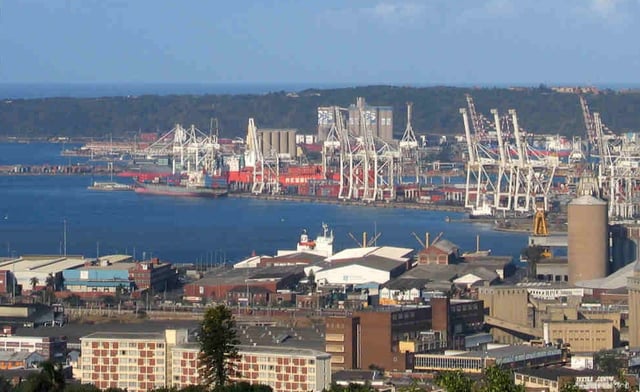
Durban harbour
Durban has a long tradition as a port city.
The Port of Durban, formerly known as the Port of Natal, is one of the few natural harbours between Port Elizabeth and Maputo, and is also located at the beginning of a particular weather phenomenon which can cause extremely violent seas. These two features made Durban an extremely busy port of call for ship repairs when the port was opened in the 1840s. Durban is now the busiest port in South Africa, as well as the third busiest container port in the Southern Hemisphere.
MSC Cruises bases one of their cruise ships in Durban from November to April every year. From the 2019/2020 Southern Africa cruise season MSC Cruises will be basing the MSC Orchestra in Durban.[53] Durban is the most popular cruise hub in Southern Africa. Cruise destinations from Durban on the MSC Musica include Mozambique, Mauritius, Réunion, Madagascar and other domestic destinations such as Port Elizabeth and Cape Town. Many other ships cruise through Durban every year, including some of the world's biggest, such as the RMS Queen Mary 2, the biggest ocean liner in the world. Durban will be building a brand new R200 million cruise terminal that will be operational in October 2019, the Durban Cruise Terminal. The tender was awarded to KwaZulu Cruise Terminal (Pty) Ltd which is 70% owned by MSC Cruises SA and 30% by Africa Armada Consortium. The new cruise terminal will be able to accommodate two cruise ships at any given time.[54]
Naval Base Durban on Salisbury Island (now joined to the mainland and part of the Port of Durban), was established as a naval base during the Second World War. It was downgraded in 2002 to a naval station. In 2012 a decision was made to renovate and expand the facilities back up to a full naval base to accommodate the South African Navy's offshore patrol flotilla.[55] In December 2015 it was redesignated Naval Base Durban.[56]
Rail
Durban featured the first operating steam railway in South Africa when the Natal Railway Company started operating a line between the Point and the city of Durban in 1860.[57]
Shosholoza Meyl, the passenger rail service of Spoornet, operates two long-distance passenger rail services from Durban: a daily service to and from Johannesburg via Pietermaritzburg and Newcastle, and a weekly service to and from Cape Town via Kimberley and Bloemfontein. These trains terminate at Durban railway station.
Metrorail operates a commuter rail service in Durban and the surrounding area. The Metrorail network runs from Durban Station outwards as far as Stanger on the north coast, Kelso on the south coast, and Cato Ridge inland.
A high-speed rail link has been proposed, between Johannesburg and Durban.[58]
Roads
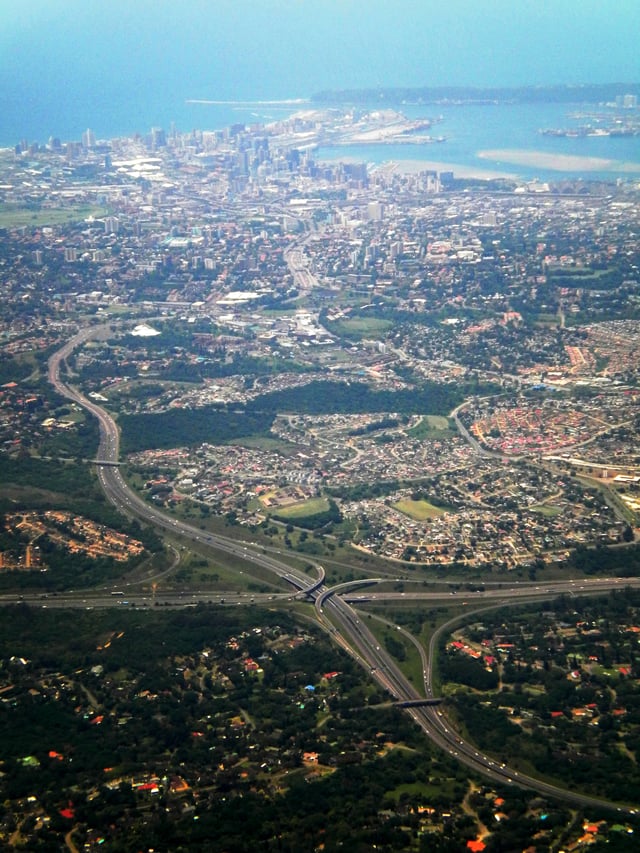
N3 freeway on its approach to Durban's CBD, with N2–N3 stack interchange in the foreground
The city's main position as a port of entry onto the southern African continent has led to the development of national roads around it. The N3 Western Freeway, which links Durban with the economic hinterland of Gauteng, heads west out of the city. The N2 Outer Ring Road links Durban with the Eastern Cape to the south, and Mpumalanga in the north. The Western Freeway is particularly important because freight is shipped by truck to and from the Witwatersrand for transfer to the port.
The N3 Western Freeway starts in the central business district and heads west under Tollgate Bridge and through the suburbs of Sherwood and Mayville.
The EB Cloete Interchange (which is informally nicknamed the Spaghetti Junction) lies to the east of Westville, allowing for transfer of traffic between the N2 Outer Ring Road and the Western Freeway.
The N2 Outer Ring Road cuts through the city from the north coast to the south coast.
It provides a vital link to the coastal towns (such as Scottburgh and Stanger) that rely on Durban.
Durban also has a system of freeway and dual arterial metropolitan routes, which connect the sprawling suburbs that lie to the north, west and south of the city.
The M4 exists in two segments. The northern segment, named the Ruth First Highway, starts as an alternative highway at Ballito where it separates from the N2. It passes through the northern suburbs of Umhlanga and La Lucia where it becomes a dual carriageway and ends at the northern edge of the CBD. The southern segment of the M4, the Albert Lutuli[59] Highway, starts at the southern edge of the CBD, connecting through to the old, decommissioned Durban International Airport, where it once again reconnects with the N2 Outer Ring Road.
The M7 connects the southern industrial basin with the N3 and Pinetown via Queensburgh via the N2. The M19 connects the northern suburbs with Pinetown via Westville.
The M13 is an untolled alternative to the N3 Western Freeway (which is tolled at Mariannhill). It also feeds traffic through Gillitts, Kloof, and Westville. In the Westville area it is called the Jan Smuts Highway, while in the Kloof area it is named the Arthur Hopewell Highway.
A number of streets in Durban were renamed in the late 2000s to the names of figures related to the anti-apartheid struggle, persons related to liberation movements around the world (including Che Guevara, Kenneth Kaunda and SWAPO), and others associated with the governing African National Congress.[60] A few street names were changed in the first round of renaming, followed by a larger second round.[61] The renamings provoked incidents of vandalism,[62] as well as protests from opposition parties[63] and members of the public.[64]
Buses
Several companies run long-distance bus services from Durban to the other cities in South Africa.
Buses have a long history in Durban.
Most of them have been run by Indian owners since the early 1930s.
Privately owned buses which are not subsidised by the government also service the communities.
Buses operate in all areas of the eThekwini Municipality.
Since 2003 buses have been violently taken out of the routes and bus ranks by taxi operators.[65]
Durban was previously served by the Durban trolleybus system, which first ran in 1935.[66]
Taxis
Durban has two kinds of taxis: metered taxis and minibus taxis. Unlike in many cities, metered taxis are not allowed to drive around the city to solicit fares and instead must be called and ordered to a specific location. A number of companies service the Durban and surrounding regions. These taxis can also be called upon for airport transfers, point to point pickups and shuttles.
Mini bus taxis are the standard form of transport for the majority of the population who cannot afford private cars.[68][69][70] With the high demand for transport by the working class of South Africa, minibus taxis are often filled over their legal passenger allowance, making for high casualty rates when they are involved in accidents. Minibuses are generally owned and operated in fleets, and inter-operator violence flares up from time to time, especially as turf wars over lucrative taxi routes occur.[71]
In recent years the ride sharing apps Uber and Taxify have been launched in Durban and are also used by commuters.[72]
Rickshaws
Although rickshaws have been a mode of transportation since the early 1900s, they have been displaced by other forms of motorised transport, and the 25 or so remaining rickshaws mostly cater to tourists.[73]
Educational institutions
Private schools
Al Falaah College
Clifton School
Crawford College, La Lucia
Crawford College, North Coast
Durban Girls' College
Durban Preparatory High School
Eden College Durban
Highbury Preparatory School
Hillcrest Christian Academy
Holy Family College
St. Francis College, Marianhill
Kearsney College
Maris Stella School
Orient Islamic School
Roseway Waldorf School
Star College, Westville, KwaZulu-Natal
St. Henry's Marist Brothers' College
St. Mary's Diocesan School for Girls, Kloof
Thomas More College
Public schools
Adams College
Bechet High School
Brettonwood High School
Crossmoor Secondary School
Danville Park Girls High School
Durban Academy High School
Durban Girls' High School (DGHS)
Durban Girls' Secondary School
Durban High School (DHS)
Durban North College
Enaleni High School (EHS)
Gelofte Skool
George Campbell School of Technology
Glenwood High School
Grosvenor Boys High School
Grosvenor Girls High School
Hillcrest High School
Hunt Road Secondary School
Inanda Seminary School
Isipingo Secondary School[74]
Kingsway High School
Kharwastan Secondary
Kloof High School
Kloof Junior Primary School
Kloof Pre-Primary School
Kloof Senior Primary School
Marklands Secondary School
Montarena Secondary School
Mowat Park High School
Northlands Girls' High School
Northwood School
Ogwini Comprehensive High School
Pinetown Boys' High School
Pinetown Girls' High School
Port Natal High School
Queensburgh Boys High School
Queensburgh Girls' High School
Ridge Park College
Sastri College, Durban
Savannah Park Secondary School
Simla Primary School
Virginia Preparatory School[75]
Westville Boys' High School
Westville Girls' High School
Wingen Heights Secondary
Woodhurst Secondary
Tertiary institutions
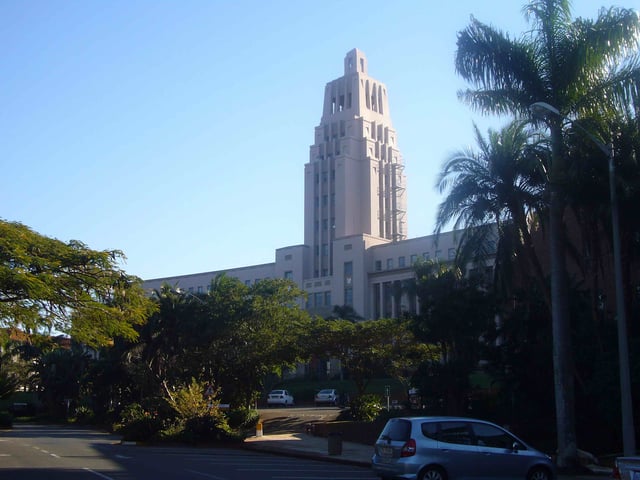
Memorial Tower Building, Howard College Campus, University of KwaZulu-Natal
Durban University of Technology
Mangosuthu University of Technology
Regent Business School
University of KwaZulu-Natal
University of South Africa
Varsity College (South Africa)
Management College of Southern Africa
Oval International
Places of worship
Among the places of worship, they are predominantly Christian churches and temples : Zion Christian Church, Apostolic Faith Mission of South Africa, Assemblies of God, Baptist Union of Southern Africa (Baptist World Alliance), Methodist Church of Southern Africa (World Methodist Council), Anglican Church of Southern Africa (Anglican Communion), Presbyterian Church of Africa (World Communion of Reformed Churches), Roman Catholic Archdiocese of Durban (Catholic Church).[79] There are also Muslim mosques and Hindu temples.
Crime and safety
There were 1,396 homicides in the Durban metropolitan area (Ethekwini) in 2017.
The murder rate in 2017 was 38.1 per 100,000 people (for comparison, Detroit had a murder rate per 100,000 of 39.7 in 2017, New York 3.4 and London 1.2).[80] The murder rate for the whole of South Africa was 35.7 per 100,000.[81] Today, Durban has a higher murder rate than Johannesburg but significantly lower than Cape Town which had a murder rate of 62.3 per 100,000 in 2017. Previously Johannesburg had the highest murder rate but Cape Town has taken its place due to a surge in gang violence there. Gang warfare is less common in Durban today.[82]
Criminals usually avoid targeting tourists because they know that the police response will be greater.[83]
Heist or theft is a common crime in the city.[84] Most houses are protected by high walls and wealthier residents are often able to afford greater protection such as electric fencing, private security or gated communities.[85] Crime rates vary widely across the city and most inner suburbs have much lower murder rates than in outlying areas of Ethekwini. Police station precincts recording the lowest murder rates per 100,000 in 2017 were Durban North (7), Mayville (8), Westville (12) and Malvern (12). Kwamashu (76) and Umlazi (69) are some of the most dangerous areas.[86] Other crime comparisons are less valuable due to significant under-reporting especially in outlying areas.
There was a period of intense violence in the 1990s and the Durban area recorded a murder rate of 83 per 100,000 in 1999.[87] The murder rate dropped rapidly in the 2000s and has increased slightly in the 2010s.
Durban is one of the main drug trafficking routes for drugs exiting and entering Sub-Saharan Africa.
The drug trade has increased significantly over the past 20 years.[88]
International relations
Twin towns and sister cities
Alexandria, Egypt
Bulawayo, Zimbabwe
Chicago, Illinois, US
Gwangju, South Korea
Kaohsiung]]]]], Taiwan
Leeds, UK
Maracaibo, Venezuela
Maputo, Mozambique
Nantes, France
New Orleans, Louisiana, US
Oran, Algeria
Rotterdam, Netherlands
See also
Art Deco in Durban
Black December
Durban Industry Climate Change Partnership Project (DICCPP)
Durban International Film Festival
Durban Youth Council
Emmanuel Cathedral
List of people from Durban, Kwazulu-Natal, South Africa
Riverside Soofie Mosque and Mausoleum
World Conference against Racism 2001 – held in Durban